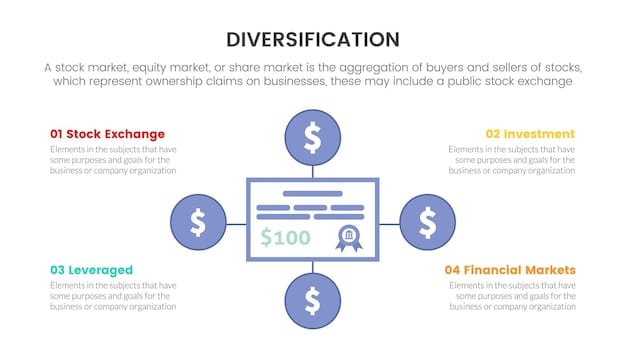Investing for Beginners: Decoding Stock Market Jargon & Key Terms

Investing for Beginners: Decoding Stock Market Jargon and Understanding Key Financial Terms explains complex financial concepts in simple terms, empowering new investors to navigate the stock market with confidence and make informed investment decisions.
Embarking on your investment journey can feel like entering a maze filled with unfamiliar terms and complex concepts. This guide, **Investing for Beginners: Decoding Stock Market Jargon and Understanding Key Financial Terms**, aims to simplify the process, providing you with a clear understanding of the essential language and principles needed to navigate the stock market confidently.
Understanding the Basics: What is Investing?
Investing is essentially allocating money with the expectation of receiving a future benefit. This benefit often comes in the form of increased income or profit. It’s a fundamental tool for building wealth over time. It’s important to understand the various avenues available to you.
Investing differs from saving, which typically involves putting money aside in a low-risk account for short-term goals. Investing, on the other hand, is generally for longer-term objectives and involves taking on some level of risk in pursuit of higher returns.
Why is Investing Important?
Investing offers the potential to grow your money faster than simply saving it. Over time, the power of compounding can significantly increase your wealth. Moreover, investing can help you achieve various financial goals, such as retirement, buying a home, or funding your children’s education.
Different Avenues for Investment
The world of investing offers diverse opportunities. Here are some of core types:
- Stocks: Represent ownership in a company and offer the potential for high growth, but also carry higher risk.
- Bonds: Represent loans to a government or corporation and are generally considered less risky than stocks, providing a more stable income stream.
- Mutual Funds: Pool money from multiple investors to invest in a diversified portfolio of stocks, bonds, or other assets, offering instant diversification and professional management.
In conclusion, understanding what investing is, why it’s important, and the various avenues available is the first step towards building a secure financial future. It is not an overnight process, but a consistent and dedicated effort.

Decoding Common Stock Market Jargon
One of the biggest hurdles for new investors is the confusing jargon often used in the stock market. Demystifying these terms is crucial for understanding financial news, making informed decisions, and communicating effectively with financial professionals. Understanding these terms will help you have a better understanding of the industry as a whole.
Let’s break down some of the most common terms and concepts you’ll encounter as you delve into investing. This will give you the confidence you need to start your journey.
Key Stock Market Terms Explained
Here’s a walkthrough of some of the most common terms:
- Stocks: Also known as equities, represent ownership in a company. Buying stock makes you a shareholder, entitled to a portion of the company’s profits and assets.
- Bonds: Debt instruments issued by corporations or governments to raise capital. Investors lend money to the issuer and receive interest payments in return.
- Dividends: Payments made by a company to its shareholders, typically from profits. Dividends can be a significant source of income for investors.
More jargon to understand
There is more jargon to learn so you can be more confident with your investing:
- Portfolio: A collection of all your investments, including stocks, bonds, mutual funds, and other assets. Diversifying your portfolio is crucial for managing risk.
- Volatility: The degree to which the price of an asset fluctuates over time. Higher volatility generally indicates higher risk.
- Bull Market: A period of sustained growth in the stock market, characterized by rising prices and investor confidence.
By understanding these common terms, you’ll be better equipped to navigate the complexities of the stock market and make informed investment decisions.
Understanding Financial Statements: A Beginner’s Guide
Financial statements are the language of business. For investors, they’re essential tools for evaluating a company’s performance and making informed decisions about whether to invest. While they might seem daunting at first, understanding the basics of financial statements can significantly improve your investment acumen.
There are three primary types of financial statements: the income statement, the balance sheet, and the cash flow statement. Each provides a different perspective on a company’s financial health.

The Income Statement: Profitability Snapshot
Another term for the income statement is profit and loss (P&L) statement, it reports a company’s financial performance over a specific period, typically a quarter or a year. It starts with revenue, then subtracts expenses to arrive at net income, or profit.
The formula is simple: Revenue – Expenses = Net Income. Investors use the income statement to assess a company’s profitability and growth trends.
The Balance Sheet: Assets, Liabilities, and Equity
You can look at the balance sheet as a snapshot of a company’s assets, liabilities, and equity at a specific point in time. It follows the accounting equation: Assets = Liabilities + Equity.
The Cash Flow Statement: Tracking the Money
The cash flow statement tracks the movement of cash both into and out of a company over a period of time. It categorizes cash flows into three activities: operating, investing, and financing.
By understanding these key financial statements, you can gain valuable insights into a company’s financial health, performance, and prospects. This knowledge is crucial for making informed investment decisions.
Risk Tolerance and Investment Strategies
Successful investing requires aligning your investment strategy with your risk tolerance. Risk tolerance refers to your ability and willingness to withstand potential losses in exchange for the possibility of higher returns. Understanding your own risk tolerance is one of the keys to a long investing career.
Different investors have different risk tolerances, based on factors such as their age, financial situation, investment goals, and personality. Evaluating your risk tolerance is an essential step in developing a suitable investment strategy.
Assessing Your Risk Tolerance
You ca assess your risk tolerance by answering these questions:
- What are my financial goals? Are you saving for retirement, a down payment on a house, or another long-term goal?
- What is my time horizon? How long do you have until you need to access your investment funds?
- What is my comfort level with potential losses? How would you react to a significant decline in the value of your investments?
Strategies for Different Risk Profiles
Here’s a brief summary:
- Conservative Investors: Typically prefer low-risk investments such as bonds and dividend-paying stocks. Their goal is to preserve capital and generate a steady income stream.
- Moderate Investors: Comfortable with a mix of stocks and bonds, seeking a balance between growth and stability.
- Aggressive Investors: Willing to take on higher risk in pursuit of higher returns, investing primarily in stocks and other growth-oriented assets.
Understanding your risk tolerance and choosing an investment strategy that aligns with it is crucial for achieving your financial goals and maintaining peace of mind.
Diversification: Spreading Your Risk
Diversification is a risk management technique that involves spreading your investments across a variety of assets to reduce the impact of any single investment on your overall portfolio. It’s a fundamental principle of investing and a crucial tool for managing risk. The principle is very simple: “Don’t put all your eggs in one basket.”
The goal of diversification is to reduce the volatility of your portfolio and improve your chances of achieving consistent returns over the long term. By spreading your investments across different asset classes, sectors, and geographic regions, you can minimize the impact of any one investment performing poorly.
Benefits of Diversification
Here are three benefits:
- Reduced Volatility: Diversification can help smooth out the fluctuations in your portfolio’s value, reducing the risk of significant losses.
- Improved Returns: By investing in a variety of assets, you increase your chances of capturing gains from different sectors and markets.
- Protection Against Unexpected Events: Diversification can help protect your portfolio from the impact of unexpected events, such as a company-specific crisis or an economic downturn in a particular region.
How to Diversify Your Portfolio
Here are four ways you can diversify your portfolio:
- Asset Allocation: Allocate your investments across different asset classes, such as stocks, bonds, real estate, and commodities.
- Sector Diversification: Invest in different sectors of the economy, such as technology, healthcare, energy, and consumer staples.
- Geographic Diversification: Invest in companies and markets around the world, rather than focusing solely on your home country.
- Investment Vehicles: Use mutual funds or exchange-traded funds (ETFs) to gain exposure to a diversified portfolio of assets with a single investment.
Diversifying your portfolio is an essential step in managing risk and improving your chances of achieving long-term investment success.
Long-Term Investing: The Power of Compounding
Long-term investing is an investment strategy that focuses on holding investments for an extended period, typically several years or even decades. It emphasizes patience and discipline, aiming to capitalize on the power of compounding and the long-term growth potential of the stock market. Time is your ally when it comes to investing.
Compounding is the process of earning returns on your initial investment, as well as on the accumulated interest or profits from previous periods. Over time, compounding can significantly increase your wealth, as your money grows exponentially.
The Magic of Compounding
The formula for compounding is often expressed by the following:
A = P (1 + r/n)^(nt)
Where:
A = the future value of the investment/loan, including interest
P = the principal investment amount (the initial deposit or loan amount)
r = the annual interest rate (as a decimal)
n = the number of times that interest is compounded per year
t = the number of years the money is invested or borrowed for
Benefits of Long-Term Investing
Let’s look at what compounding in long-term investing can do for you:
- Higher Returns: Over the long term, the stock market has historically provided higher returns than other asset classes, such as bonds or cash.
- Reduced Risk: While the stock market can be volatile in the short term, long-term investing can help reduce risk by smoothing out the fluctuations in your portfolio’s value.
- Tax Efficiency: Long-term capital gains are typically taxed at a lower rate than short-term gains, making long-term investing a tax-efficient strategy.
Long-term investing is a powerful strategy for building wealth over time. By embracing patience, discipline, and the power of compounding, you can achieve your financial goals and secure your future.
| Key Point | Brief Description |
|---|---|
| 💰 Investing | Allocating money for future financial gain. |
| 📈 Diversification | Spreading investments to reduce risk. |
| ⏳ Long-Term Investing | Holding investments for years to grow wealth using compounding. |
| 📊 Financial Statements | Key reports like income statement, balance sheet & cash flow statement |
Frequently Asked Questions (FAQ)
▼
A stock represents ownership in a company. When you buy a stock, you become a shareholder and own a small piece of that company. You can profit if the company does well and the stock price increases.
▼
Bonds are essentially loans you make to a company or government. In return for the loan, they promise to pay you back with interest. They are generally less risky than stocks.
▼
Diversification is spreading your investments across different asset classes to reduce risk. By not putting all your eggs in one basket, you minimize the impact if one investment performs poorly.
▼
Risk tolerance is your comfort level with potential losses. Conservative investors choose low-risk options like bonds, while aggressive investors may prefer higher-risk stocks for potentially higher returns.
▼
Compounding is earning returns on your initial investment *and* on the accumulated interest. Over time, this exponential growth significantly increases your wealth, making it a cornerstone of long-term investing.
Conclusion
Starting your investment journey can be both exciting and a little daunting. Hopefully, this guide has clarified the stock market jargon and given you a solid base for understanding key financial terms. Remember, investing is a marathon, not a sprint. Taking the time to learn and understanding these terms will set you up for a successful career.





